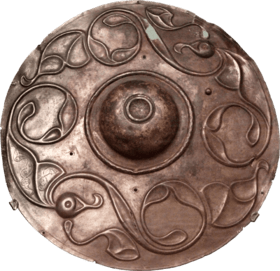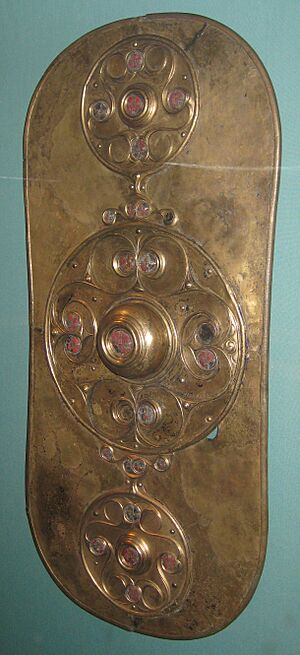Wandsworth Shield facts for kids
Quick facts for kids Wandsworth Shield |
|
|---|---|

On display in the British Museum
|
|
| Material | Bronze |
| Size | Diameter: 33.0 cm |
| Created | Iron Age, 2nd century BC |
| Place | River Thames, London |
| Present location | Room 50, British Museum, London |
| Registration | 1858,1116.2 (Wandsworth Shield) 1858,1116.3 (Wandsworth Mask Shield) |
The Wandsworth Shield is a round bronze part of an ancient Iron Age shield. It was found in the River Thames in Wandsworth, London, before 1849. This special shield part is called a shield boss, which is the raised center of a shield. It is decorated in a style called La Tène style.
Another bronze shield part, known as the Wandsworth Mask Shield, was found at the same time. Both of these amazing finds are now kept at the British Museum. The Wandsworth Shield has bold, raised decorations of two birds with wide wings and long tail feathers. A famous expert, Barry Cunliffe, thinks it's one of the "masterpieces of British Celtic art" because of its beautiful design.
Finding the Shields
The round bronze shield part, along with the incomplete mask shield, a bronze sword, and a celt (an ancient tool), were all found in the River Thames at Wandsworth. This happened during dredging work in 1849 or even earlier.
A man named William English, who used steam machines to dredge the Thames, gave these items to the Royal Archaeological Institute in December 1849. Later, in 1858, the Royal Archaeological Institute donated both shield parts to the British Museum, where they are now on display for everyone to see.
What the Shields Look Like

The round shield part is 33 centimeters wide. It has a central raised area, called a shield boss, and a flat edge around it. This part might have been the center of a larger, oblong (oval-shaped) shield, like the famous Battersea Shield.
The boss is decorated with curvy patterns in the La Tène style, showing two almost identical bird designs. In the very middle of the boss, there's a small dip. This dip would have held a decorative stud, probably made of colorful enamel, just like on the Battersea Shield.
The flat edge around the boss also has stylish designs of two big birds. They have wide, fan-shaped wings and long, flowing tail feathers. Each bird is a perfect mirror image of the other. Even more bird shapes are etched onto the wings of these two main birds using a special technique. The eye of each bird is a small dip with a rivet. This rivet would have held another stud, possibly made from red coral from the Mediterranean Sea.
The bronze shield part would have been attached to a wooden back using six rivets. Only one of these rivets is still there. It sticks out 8 millimeters, which tells us that the wooden part of the shield was probably no thicker than 8 millimeters.
The Mask Shield
The other bronze shield part is not complete. It has a central boss that is about 11.85 centimeters wide. This boss then changes into a half-round spine (a long, narrow part) at the top and bottom. One end of this spine is broken, but the other end finishes with a face that looks like a human.
The part of the mask shield that is left is 37 centimeters long. It is similar to the boss and middle spine found on the Witham Shield. The central boss has raised designs and very detailed spiral patterns, showing the heads of two ducks. The human-like face at the end has three tiny spirals etched on its nose and a row of triangles that look like teeth.
This bronze mask shield would have been attached to a long, wooden shield with at least seven rivets. The length of these rivets also suggests that the wooden backing was no more than 8 millimeters thick.
Ancient Gifts
Both the round shield part and the mask shield are very old. The round shield is from the 2nd century BC, and the mask shield is from the later 3rd century BC. Experts believe that these shields, along with other Iron Age shields found in rivers (like the Battersea Shield and the Witham Shield), were likely votive offerings. This means they were special gifts thrown into the rivers for the gods, perhaps as a way to ask for good luck or give thanks.
The style of these shields, especially the detailed etchings, is very similar to the Torrs Pony-cap and Horns. This ancient object was found in Scotland and is now in the Museum of Scotland.
See also

